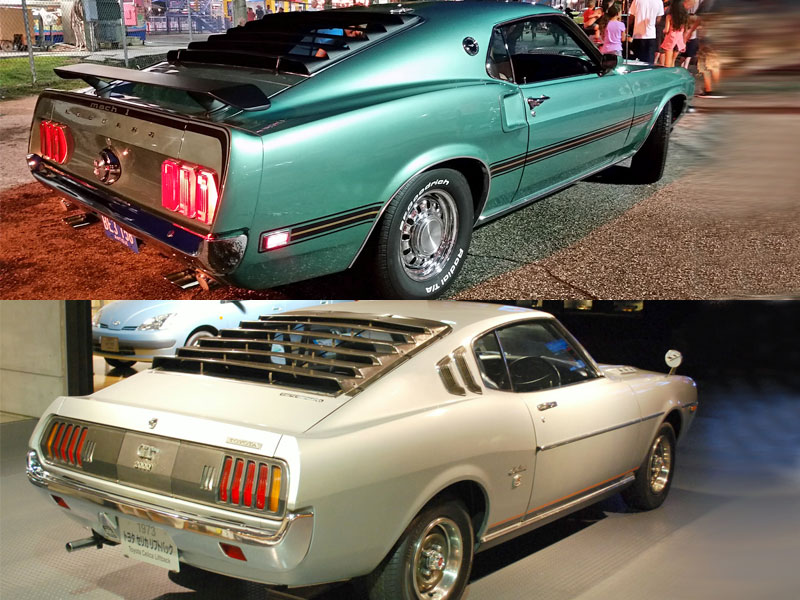

It’s impossible to live in the world and not be influenced by it. Any automotive designer can copy another, even one holding the highest virtues—an appreciation of his predecessors’ work, a desire to produce organic material, a grave respect for intellectual property rights—can’t help but incorporate favorite shapes and features into his or her original designs. One of the designers of the iconic Datsun 240Z, Albrecht von Goertz, was also responsible for the BMW 507 and admitted to a lifelong love of the Jaguar E-Type. As such, cues from both cars made it into the Japanese coupe—though as part of a wholly new design. Datsun referenced the luxurious Europeans without lifting anything wholesale. That’s fair, that’s square, that’s design.
But sometimes, a reference can read as a ripoff. Sometimes, instead of iterating on an existing expression, automakers—as well as speakers at the Republican National Convention—take tracing paper to another person’s work, reproducing it without a whiff of innovation. China’s burgeoning automotive manufacturing sector is infamous for ripping off Western designs (and we’ve included some choice examples) but even more upstanding brands have been known to poach.
Here, then, are seven of the most obvious instances of automotive plagiarism. Imitation may be a sincere form of flattery, but it’s also baldy uncreative. We at The Drive demand more from our cars—and, now and again, a potential FLOTUS.
Bentley Continental Flying Spur / Lincoln Continental Concept
We applaud Lincoln’s full-size sedan concept, but the likeness is unmistakable. Following the LIncoln’s unveiling, Bentley’s chief designer, Luc Donckerwolke, famously wrote on Lincoln designer David Woodhouse’s Facebook wall: “Do you want us to send the product tooling?” We wish Lincoln had pulled from their own back catalog, because it’s one of the best.
Porsche 944 / Nissan 300ZX Z53
While the Porsche 924/944 didn’t originate clamshell headlights or a sleek hatchback shape, it did offer the most compelling marriage of the two. Seeing as much, designers at Nissan cribbed the Porsche’s profile for their powerful, turbocharged 300ZX. In its favor, come 1984, the Nissan did have a computerized female voice that would warn drivers when fuel dropped to ⅛ of a tank.
1969 Ford Mustang / 1973 Toyota Celica Liftback
Though the ‘73 Celica borrowed liberally from the Chevrolet Camaro around front, its true copycat nature was revealed at the rear, where it seems Toyota’s designers Xeroxed a ‘69 Ford Mustang fastback—replete with louvers—at 75% and glued the resulting image to the rear of their coupe.
Mercedes E-Class W210 / Kia Amanti
The Kia we know today is a legitimate Honda competitor, with stellar build quality and handsome designs. But, as recently as 2010, Kia was producing the Amanti, one of the saddest facsimiles of a luxury car to come from any country. With a face cribbed from the W210-generation Mercedes-Benz E-Class and an odd roofline from the Jaguar S-Type, the Amanti was all pastiche, no panache.
Hummer H1 / Dongfeng EQ2050
While AM General did, for a time, license its Hummer H1 civilian design to Chinese manufacturer Dongfeng, that license expired years ago. Still, Dongfeng’s production line has been humming merrily ever since, producing carbon copies of Arnold Schwarzenegger’s favorite truck.
Rolls-Royce Phantom / Geely GE
If you’re going to copy, why not copy the best? That’s why half of Washington D.C. looks like The Parthenon. So, Geely, a major Chinese automaker that now owns Volvo, decided to style its luxurious GE saloon after the mammoth Rolls-Royce Phantom. But the Chinese company couldn’t stick the landing; while details are important—like the fiber-optic “Starlight” roof ripped right from the Roller—proportions are what truly matter on an ultra-luxury limousine. Sadly, the Geely GE has the proportions of a chicken coop.
Land Rover Range Rover Evoque / Landwind X7
When the Range Rover Evoque was released, any worries about a citified Rangie evaporated: It was stylish, nimble and luxurious. Sales have been excellent. Hoping to cash in, Jiangling Motors Co. launched its “Land Wind” brand—and with it, the X7, a near-carbon copy of the Evoque for a third of the price. While the Evoque comes with Land Rover’s patented Terrain Response system, the X7 counters with a compelling zero-star Euro NCAP rating. It’s a tough call.